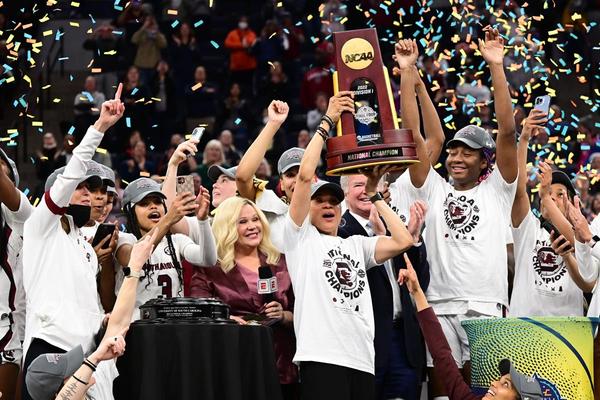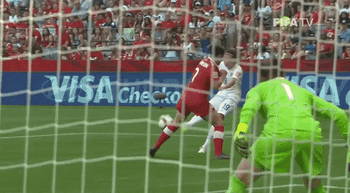Improving the media landscape in women's sports

📺 Broadcast rights
A new year means new broadcast deals, and record-setting fees are on the horizon. The NCAA will head to market with around 30 different championships this year, and have the rare opportunity to unbundle increasingly popular women’s sports tourneys from men’s to maximize profits — women’s March Madness could reportedly fetch nine figures on its own.
- As for pro sports, the NWSL is already chatting with prospective media partners as its deal with CBS expires this year, and the WNBA is currently putting out feelers for a nine-figure agreement before its agreement with ESPN ends in 2025.
These sports organizations can also negotiate for more than just bigger price tags. Steady audience growth means the NCAA, the NWSL and others have unprecedented leverage to score more (and better) broadcast time slots, a crucial element to foster the next phase of engagement.
- As Gaming Society’s VP of business development and former WNBAer Marissa Coleman described it, “We can’t [meet] the masses unless we’re putting it on TV more [and] we’re promoting games, unless people know where they can watch the Mystics or the Aces play.”
- Coleman added that larger TV deals will move the needle “because the more eyes you’re going to be able to put on something, the more accessible it is. That’s how you help something grow.”
Strong broadcast agreements are arguably the first step to capitalizing on the overall potential of women’s sports, according to ex–NJ/NY Gotham FC chief business officer Andrea Pagnanelli. “There’s only so much that I can do on the team side. …Unless we are on a platform where you can easily discover women’s sports, it’s going to be hard for us to grow.”
📲 The media landscape at large
The push for more screen time is the natural result of women’s sports making their limited broadcast minutes count — the NWSL’s first primetime championship game in October set the league’s viewership record, and this year’s March Madness final will head to network TV after a whopping 4.85 million tuned in last year.
That success creates a unique knock-on effect, per Ally CMO Andrea Brimmer. Increased coverage means champions of women’s sports now have a seat at the sports media table. “You can feel this group starting to congeal and come together and hold people accountable and prove out the business cases and insist on change,” Brimmer said.
- Shifting narratives may favor those leading the charge. “I think female-led media platforms are going to be the next big thing in women’s sports,” she added. Ally plans to act on it — Brimmer said the financial services company is looking at investing in these channels.
- Investment like increased media spend may be a necessary catalyst for change. In addition to supporting The Athletic’s journalism, Google’s sponsorship dollars led to more air time for women’s hoops and Ally helped the NWSL score its first primetime championship. If you build it…
Buzz generated by women-led platforms (like yours truly) is a game-changing wake-up call for traditional media, according to NWSL commissioner Jessica Berman. “Now that there’s entrepreneurs investing in the perceived gap in that space, the legacy media brands are recognizing that they had been missing an opportunity from a business perspective,” she said.
There’s room for everyone to ride the women’s sports tidal wave because the industry has barely scratched the surface on its potential. Billie Jean King noted creating more leagues and opportunities for female athletes is needed, and she’s leading the way — the tennis legend entered a formal relationship with the PWHPA last year to launch a women’s hockey league.
- It all ties into female athletes’ specific appeal during a period of rapid shifts in cultural opinions globally. “I think they believe in themselves, finally, more than they did in my generation,” King said. “I think they see the dream better.”
👀 Looking ahead
The newness of the women’s sports media space means partners old and new have plenty to figure out. A primary concern is producing high-quality broadcasts, an issue the NWSL began to rectify last summer. The league upgraded cameras and infrastructure for Paramount+ and Twitch streams and employed more broadcast staff.
Another pressing issue? Striking the balance between linear and streaming as American audiences continue to cord cut. Around 60% of U.S. households currently pay for cable, down from 79% just five years ago. Live sports continue to be the lifeblood of TV, but women’s and men’s sports leagues need a digital presence to attract younger fans.
- Most leagues have distinct visibility on linear and streaming, and the WNBA plans to keep it that way when it negotiates a new deal. On the men’s side, MLS’ brand-new deal with Apple will serve as a case study for moving most games behind a digital paywall.
As more women’s sports leagues form, like the PWHPA’s future startup and America’s multiple new volleyball orgs, the onus will be on all media companies to meet the moment. Audiences will always watch marquee events, but comprehensive coverage will be the only way to fully gauge and grow interest.
🔮 What else the experts are predicting
The growth opportunities in women’s sports are seemingly endless. Outside of media, here are a few other areas of expansion industry experts are eyeing this year.
Julie Foudy, USWNT legend: “I’ve always been fascinated that volleyball, both indoor and outdoor, just hasn’t taken off. … That game is so fun to watch on the women’s side. You’re seeing huge attendance in college games [last] year, and I feel like that’s an area that’s ready to explode in such a good way.”
Brittni Donaldson, Strata Athletics co-founder: “I would love to see football blow up for women. … I think there should be women’s professional tackle football in North America.”
Michelle Garsha, Hologic president of diagnostic solutions: “Athletes, because they obviously have to fixate so much on health, have such a platform to be an inspiration for other women. I do see sports teams transitioning into [not] only advocating for sports but advocating for health and wellness.”
Kate Veronneau, Zwift director of women’s strategy: “I just think that fanbases are going to blow up in the next few years. With social media opportunities and … continued broadcasts … I think it’s going to be shocking how much interest there is in women’s sports and that there’s going to be so much great investment that comes along with that.”
Enjoying this article? Want more?

Sign up for The GIST and receive the latest women's sports business news straight to your inbox three times a week

